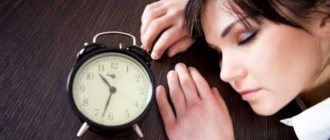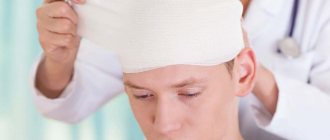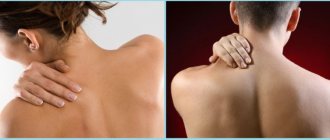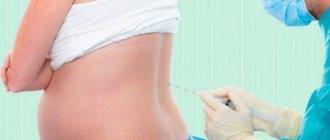Types of morning headaches
There are many causes of headaches in the morning. This symptom is the body’s reaction to receptor irritation, and therefore occurs with any disorder. Receptors are located in the skin, muscles and soft tissues, meninges, as well as on the inner wall of blood vessels. Depending on the type and mechanism of development, several types of headaches after sleep can be distinguished.
- Vascular headache – this type includes cerebral atriovenous dystonia. One of the mechanisms for the development of pain is stretching of the vascular walls due to increased blood pressure and a decrease in their tone. Pain can also occur when there is a sharp spasm of blood vessels or when there is a violation of the outflow of fluid and its accumulation in the venous bed.
- Tension headaches are caused by muscle spasms in the neck and head. They compress nerves and blood vessels, blocking blood access to the brain. This type of pain can be associated with intense physical or mental stress, stress, and nervous tension. It is also caused by chronic diseases of the cervical spine, intoxication and other factors.
- Neuralgic – associated with inflammation or compression of the trigeminal nerve. The pain is acute, throbbing, and often worsens after sleep or prolonged periods without movement. Neuralgia is characterized by increased symptoms in a certain position, during pressure on the damaged nerve.
- Liquorodynamics - the reason why the head hurts in the morning is a deterioration in the drainage of fluid from the brain. As a result, intracranial pressure increases, which leads not only to constant pain, but also to nervous disorders, problems with hearing and vision, and slow development in children.
- Headache of a psychogenic nature - occurs during stress, sleep disturbances, and nervous tension. During the examination, no pathologies are detected, and the pain is caused by increased activity of the nervous system.
Most patients experience headaches of mixed origin. When diagnosing one problem, several violations are detected simultaneously, which complement each other. It is important to determine which of them is the main one and begin treatment.
Factors not associated with head diseases
External stimuli that can affect a person’s general well-being are listed in the following list:
- Insufficient rest period, which leaves less than seven hours.
- Oversleeping.
- Drinking alcohol before going on vacation or stimulating energy drinks, including coffee.
- Staying in front of a TV or computer screen for a long time, exposure to blue lighting, flickering, irritating visual receptors, why do you get a headache after sleep?
- Uncomfortable posture leading to prolonged muscle tension.
- Overheating or prolonged exposure to the sun.
- Depressive state.
A person may simply systematically not get enough sleep due to his own or someone else’s snoring or other external noise.
Reasons why your head hurts after sleep
If you have a headache every morning, this may indicate various diseases. They may be associated with vascular or nervous pathologies, infectious and inflammatory processes, as well as other factors. Each disease requires its own treatment regimen, which is prescribed by a doctor.
Sleep apnea
Obstructive sleep apnea is a dangerous disorder that causes breathing to stop for more than 10 seconds. The disease is associated with a blockage of the oropharynx, as a result of which air cannot move through the respiratory tract. Pathology often occurs in people with certain anatomical features: a voluminous base of the tongue or palatine tonsils, a retracted lower jaw, a short and wide neck. Also at risk are people with obesity, thyroid dysfunction, diabetes and cardiovascular diseases.
Sleep apnea can be identified by characteristic signs:
- difficulty breathing or suffocation that occurs during sleep;
- frequent snoring;
- increased fatigue during the day;
- impaired concentration;
- headaches after sleep.
According to statistics, sleep apnea is more often diagnosed in men. There is also a family predisposition - the disease occurs simultaneously in several relatives. Advanced stages can lead to various heart rhythm disturbances and hypertension, which is poorly controlled with medications.
Increased blood pressure
Hypertension is a chronic increase in blood pressure. The disease is diagnosed if the systolic pressure is 140 mm. rt. Art. and higher, diastolic - more than 90 mm. rt. Art. The condition can be caused by heart disease, dysregulation of vascular tone, and slower removal of excess fluid from the body. Elderly people, patients with obesity and endocrine pathologies are at risk. Hypertension can also be triggered by long-term use of hormonal drugs.
With high blood pressure, you often get a headache after sleep. The condition also manifests itself with other characteristic symptoms:
- chronic fatigue, decreased concentration;
- deterioration of hearing and vision;
- frequent headaches - they are pressing, chronic, and often worsen with changes in atmospheric pressure;
- redness of the facial skin and mucous membranes.
If you have hypertension, it is important to monitor your blood pressure using a tonometer. The condition is dangerous because it causes stretching and weakening of arterial walls and can cause stroke and heart attack. To correct blood pressure, medications are prescribed that improve blood flow in the vessels and stimulate the removal of excess fluid.
Infectious diseases
A common reason for a headache in the morning after sleep is respiratory viral diseases. They are manifested by a sore throat, cough, rhinitis, and complications such as conjunctivitis, bronchitis and pneumonia are possible. However, in the initial stages, the only symptom may be a morning headache. If it is accompanied by general weakness and fever, other symptoms develop within a few days.
Precipitating factors that can lead to colds and flu include:
- hypothermia - the incidence rate increases in winter and in the off-season;
- the presence of any chronic diseases;
- pathologies of the immune system – patients are more susceptible to viral infection;
- elderly age.
The main cause of viral respiratory diseases is a decrease in the body's immune defense. The infection constantly reaches the mucous membranes, but immune cells stop their further reproduction. If this does not happen, the virus enters the bloodstream and causes typical signs of disease. For their treatment, antiviral and symptomatic drugs are used, and bed rest is also indicated.
Sinusitis
If you often have a headache in the morning and evening, this may indicate the development of sinusitis - inflammation of the mucous membrane of the paranasal sinuses. They are cavities formed by the bones of the skull. Inflammatory processes cause acute headache, chronic rhinitis, fever and deterioration of smell. The sinuses, which contain air in a healthy person, fill with liquid contents. The fluid may be clear or contain pus due to bacterial infection.
There are several types of sinusitis, depending on the location of the paranasal sinuses:
- sinusitis - one of the most common forms, develops with inflammation of the mucous membrane of the maxillary (maxillary) sinus;
- ethmoiditis - the inflammatory process affects the mucous membrane of the ethmoid bone cells;
- frontal sinusitis - occurs in the frontal sinus, often occurs in a complicated form due to difficult exit of sinus contents;
- sphenoiditis is a pathological process on the posterior part of the ethmoid labyrinth.
Sinusitis can occur as a complication after flu and colds, if you do not complete the full course of treatment and are not completely free from the infection. Diseases also develop after traumatic brain injuries, in which there is damage to the bones that form the paranasal sinuses. Treatment necessarily includes taking antibiotics. If conservative therapy is not effective enough, it is necessary to remove the contents of the sinuses by puncture.
Migraine
If you have a headache every morning, this could be the first sign of a migraine. It is an acute headache that develops without any organic disorders. It is believed to be associated with vascular disorders. The disease often manifests itself simultaneously in several family members, which proves a genetic predisposition.
Migraine often occurs in a chronic form and has a recurrent course. The onset of an attack can be determined by the aura - signs that appear several hours before the headache appears. These include:
- nausea, vomiting;
- cardiopalmus;
- deterioration of health, weakness, drowsiness;
- pallor of the skin and mucous membranes;
- deterioration of hearing and vision, impaired coordination of movements;
- the appearance of auditory and visual hallucinations, including tinnitus and dark circles before the eyes.
According to statistics, migraines often occur in middle-aged women. It can worsen with different frequency, and the duration of each attack ranges from several hours to 2 days. Provoking factors include changes in climatic conditions, fatigue and nervous tension, stress, hormonal imbalance and other factors. Conventional painkillers are ineffective; when diagnosing migraines, specific potent drugs are prescribed.
Other reasons
Before you start taking medications, it is important to find out why you have a headache after sleep. In most cases, occasional headaches do not indicate serious problems. They can occur even in a healthy person and be a consequence of various conditions. Pain in the morning can be caused by various reasons.
- Drinking caffeine before bed is one of the common causes of headaches in the morning. This substance activates the nervous system and stimulates the production of adrenaline into the bloodstream. If these processes occur at night, acute headaches appear the next morning.
- Alcohol abuse is a common reason for headaches in the morning after sleep. Ethyl alcohol causes poisoning and accumulates in nerve cells. It is completely eliminated from the body within 24 hours, and the state of health improves. However, drinking low-quality alcohol or large doses of ethyl alcohol leads to long-term intoxication.
- Diseases of the cervical spine also cause pain in the morning. With osteochondrosis, headaches are triggered by prolonged stay in a stationary position and deterioration of blood supply to the head.
- Violation of the medication schedule or abuse of certain drugs is another cause of morning headaches. So, it manifests itself in diabetes mellitus if you make a mistake with the dosage of medications.
- More dangerous causes that may indicate a headache are meningitis or the appearance of a tumor in the brain. In addition, this symptom may be the first manifestation of a stroke. If it is accompanied by problems with speech or coordination of movements, you must seek urgent medical help.
If you have a headache in the morning and evening, and the pain decreases during the day, this may occur after a disruption in your sleep pattern. Insomnia, alternating night and day shifts, and time zone changes lead to overwork. It is important to give your body proper rest before starting to take headache medications.
The relationship between sleep disorders and headaches
The article discusses the pathophysiological and behavioral mechanisms of the development of chronic insomnia in headaches. Particular attention is paid to the effect of sleep disorders on primary headaches – migraine and cluster headache. Data are provided on the use of melatonin in the complex treatment of chronic headaches.
Rice. 1. Pathophysiology of headache (A) and agitation (B)
Rice. 2. Descending trigeminovascular modulations
Rice. 3. Proposed biobehavioral model of the underlying mechanisms of the relationship between chronic insomnia and chronic headache
Sleep disorders affect more than 45% of the world's population, and they have become a global health problem in recent decades [1].
The connection between sleep and headaches is well known: lack of sleep can trigger another attack, and good sleep can relieve pain. Back in 1853, M. Romberg suggested that “an attack (of migraine) usually ends in a deep and refreshing sleep” [2]. And in 1873, E. Living expressed the opinion that “the easiest way to stop a migraine attack is to go to sleep” [3].
In the International Classification of Headache Disorders, Third Revision (ICHD-3, 2018), sleep is mentioned 38 times [4], and headache is listed in the International Classification of Sleep Disorders among the symptoms of sleep disorders [5]. The American Academy of Sleep Medicine calls sleep-related headache one of the characteristic complaints of headaches (migraine or other type).
Neuroanatomical structures mediating pain perception and sleep
Studying the pathophysiology and function of the hypothalamus simultaneously in headache and sleep disorders may explain the relationship between trigeminal pain perception and sleep induction. The trigeminocervical complex, which plays an important role in the formation of headaches, is connected to a number of stem structures. Nociceptive information enters the nuclei of the thalamus, the activation of which is of great importance in the development of migraine and cluster headache. The trigeminal nerve sends afferent impulses to intra- and extracranial structures and blood vessels, the spinal trigeminocervical complex (Fig. 1A) [6]. Vasoactive substances such as calcitonin gene-related peptide and substance P are important in modulating sensory trigeminal activation. Secondary neurons of the trigeminal system send ascending impulses to thalamocortical neurons. In addition, there are direct and indirect connections with the periaqueductal gray matter and the hypothalamus. The third thalamocortical neuron, in turn, has a synaptic connection with the cortex, including the motor, somatosensory and visual. Monoaminergic neurons, particularly noradrenergic, serotonergic, dopaminergic, and periaqueductal gray matter, act on the thalamus (orexin) and basal forebrain. Thus, with the development of headache, excitement is transmitted (Fig. 1B). The trigeminovascular complex receives direct and indirect modulating impulses: direct ones come from the somatosensory cortex and insula, and indirect ones from the hypothalamus. This complex provides pro- and antinociceptive interactions (Fig. 2). The suprachiasmatic nucleus of the hypothalamus receives direct impulses from the cells of the retinal ganglion and indirect signals from the environment (light - dark). The posterior neurons of the thalamus receive light signals from the retina, these neurons project to the sensory and visual cortex, which is the neuronal substrate for the development of photophobia during a migraine attack and hypersensitivity to light (see Fig. 1B). The monoaminergic nucleus inhibits the ventrolateral preoptic nucleus, which leads to stimulation of the hypothalamic (orexinergic) system and the pontine nucleus. During the transition to sleep, the orexinergic system activates the ventrolateral preoptic nucleus. Direct inhibition of the system and a decrease in orexinergic support for the sleep state determine rapid transitions from sleep to wakefulness and vice versa. The orexinergic system, including neuropeptides (orexin A and B), is represented in the posterior, lateral and paraventricular hypothalamus [7]. Orexin receptors are located in the prefrontal cortex, thalamus and subcortical areas and are involved in the modulation of nociceptive neurotransmission, thermoregulation, neuroendocrine and autonomic functions [8]. These zones are also involved in the modulation of nociceptive activation of the trigeminovascular complex [9].
Before a migraine attack, patients often yawn, feel hungry, and feel drowsy, which may be caused by changes in the hypothalamus and orexin neurons and has been confirmed in neuroimaging studies using functional magnetic resonance imaging before and during migraine attacks [10]. In this way, a connection is made between the systems that regulate the processes of sleep and wakefulness, and the systems involved in the formation of headaches.
A biobehavioral model of the mechanisms of the connection between chronic insomnia and chronic headache was proposed, which assumes three basic points:
- attempts to overcome headaches can accelerate and intensify sleep disturbances;
- disruption of sleep physiology increases the tendency to headaches;
- over time, these cycles interact and serve to transform or transition from episodic headache to chronic headache (Fig. 3) [11].
Among the important prerequisites are the traits of an anxious personality and a tendency to activate the sympathetic nervous system, which, together with psychological stress, can be a trigger for sleep disorders. Efforts to overcome sleep disorders (compensatory daytime sleep, taking sleeping pills before bed and caffeine during the day) lead to the perpetuation of chronic insomnia. This model explains the interaction between biological and psychological factors in the development of sleep disorders [11].
Comorbidity of sleep disorders and various types of headaches
According to IKGB-3 (2018), there are:
- primary headaches that are not the result of any disease;
- secondary, or symptomatic headaches, in which pain is a symptom of an underlying disease;
- cranial neuralgia and other facial pain;
- pain due to psychiatric disorders.
The group of primary headaches includes migraine, tension headache, cluster headache, and other less common variants. Primary headaches are more common in the population, accounting for 85–90% of all headache cases. It is primary headaches, such as migraines and cluster headaches, that are more often accompanied by sleep disturbances.
The connection between headaches and sleep disorders is multifaceted. On the one hand, headaches can be a consequence of sleep disorders, a typical example is hypnic headache. Patients with migraine and trigeminal autonomic cephalalgias, which include cluster headaches, report headache attacks during sleep. On the other hand, insomnia can cause the development of headaches. Population studies have revealed comorbidity between migraine and restless legs syndrome, migraine and narcolepsy.
Another aspect is that some drugs used to treat headaches can cause sleep disturbances. Beta blockers, which are the first line of preventative treatment for frequent migraine attacks, cause difficult dreams and frequent awakenings at night. They reduce the secretion of endogenous melatonin, which leads to suppression of the sleep signal and can cause sleep disturbances and sleep fragmentation. Thus, according to polysomnography, an increase in awakenings was shown when taking propranolol compared to placebo. Tricyclic antidepressants (amitriptyline), used in the treatment of frequent migraine attacks, not only reduce total sleep duration, but also increase morning and daytime sleepiness. Triptans - selective specialized drugs for the relief of migraine attacks are included in the standards and recommendations for the treatment of migraine. Frequent drowsiness may be one of the side effects of this group of drugs, which appears to be the result of a direct effect on the serotonergic system. Benzodiazepines prescribed for sleep disorders can not only aggravate headaches, but also cause them. Headache due to drug abuse is aggravated by the prescription of drugs that act on the central nervous system. On the contrary, with preventive treatment of migraine with anticonvulsants (topiramate and valproate), sleep first of all improves, which gives the first quick effect - a decrease in the intensity and frequency of migraine attacks [12].
The first large-scale epidemiological study was conducted in Denmark to assess the incidence of comorbidity between headaches and sleep disorders [13]. The survey included 68,518 people, most of whom were under 55 years old (80% answered questions offline, 20% online). 18.1% of people reported having headache and insomnia at the same time (the high frequency of comorbidity of these diseases is due to common pathophysiological mechanisms). Another 16.3% suffered only from headaches, and 21.1% only had sleep problems. Comorbid pathology was more often observed in women and middle-aged people. Risk factors also included low socioeconomic status, unhealthy lifestyle (overweight/obesity), high stress levels, anxiety and depression. The researchers concluded that it is necessary to actively identify patients with headaches and sleep disorders in clinical practice. Lifestyle changes, reducing the impact of stress, and screening for depression and anxiety can be of great importance for the treatment and prevention of the combination of headaches and sleep disorders [14].
Of all types of headaches, the attention of scientists is primarily attracted to migraine as a disease that significantly impairs work ability [13]. The frequency of migraine in the population is 14.5%. Migraine headaches are usually pulsating, unilateral, and less commonly bilateral. Migraines are often accompanied by nausea, photo- and phonophobia. Women suffer from migraines more often than men, in a ratio of 5:2.
The chronobiological pattern of migraine has been demonstrated in numerous studies. Thus, a prospective study of the chronobiology of migraine (n = 1698) found that more than half of the attacks occurred from 04:00 to 09:00 [15].
In patients with migraine, sleep disturbances can not only be triggers of attacks (in 49.8% of cases) [16], but also a factor in the chronicity of the disease.
According to the results of a study analyzing the relationship between migraine and sleep disorders, 60.5% of 1750 patients suffering from migraine had various types of sleep disorders: short sleep duration, prolonged falling asleep, daytime sleepiness, poor sleep quality, use of sleeping pills [17].
Another study examining the relationship between migraine and sleep disorders included 33 patients with migraine (15 with sleep migraine and 18 with regular migraine) [18]. Patients with sleep migraine woke up more often during the night, while patients with regular migraine had a higher frequency of slow-wave sleep and short awakenings.
In this study, as in a number of previous ones, patients with migraine were more likely to experience anxiety symptoms than patients in the control group. It is interesting to note that patients with sleep migraine were more tired during the day than patients with regular migraine. There is an assumption that the low “excitability” of patients with sleep migraine may be associated with the periaqueductal gray matter, the structures of which play a significant role in the pathogenesis of migraine [19].
Patients with migraine often complain of insomnia, daytime sleepiness, and obstructive sleep apnea. There is also a downside - sleep disturbances and a decrease in its duration can be triggers for pain attacks. To clarify the relationship between sleep duration and the frequency of migraine attacks, a study was conducted in South Korea [20]. It involved 2,695 people aged 19–69 years, of whom 143 (5.3%) suffered from migraine. Short sleep duration and poor sleep quality were observed in 47.6% of patients. In patients with migraine, the prevalence of poor quality sleep was statistically higher than in the general population. According to the results of the study, it was noted that with short duration and poor quality of sleep, migraine attacks developed twice as often. Headache intensity did not differ between migraine patients with short sleep and poor sleep quality. However, anxiety (30.1 and 13.2%, respectively), depression (16.8 and 5.9%, respectively) and insomnia (37.8 and 9.2%, respectively) were more common in patients with migraine than in the general population. .
Statistical analysis showed that the most important and independent factor in the increase in migraine attacks was sleep duration. The findings suggest that changing sleep duration will open new perspectives in the treatment of patients with migraine [21].
Another type of primary headache is cluster headache, the most common among trigeminal autonomic cephalalgias. It is characterized by severe unilateral headache and is accompanied by vegetative syndromes: redness of the eyes/face, lacrimation, rhinorrhea, nasal congestion. The pain affects the frontotemporal region and the orbital area, usually reaches 10 points on the Visual Analogue Scale and is excruciating for the patient. It is accompanied not only by vegetative symptoms in the facial area, but also by excitement and agitation. Cluster headache occurs in 0.1% of the population and is more common in men than women, with a ratio of 4:1. An important feature of the disease is a series of headache attacks with a long inter-attack period [22]. Cluster pain is distinguished from other headaches by the clear connection of attacks with the circadian rhythm. More than 75% of attacks of both episodic and chronic cluster headaches begin between 21:00 and 10:00 hours, usually between 05:00 and 07:00 hours. Cluster headache in six out of ten patients is accompanied by obstructive sleep apnea, and in some cases, as a result of treatment of apnea, remission of this headache is achieved.
A number of studies have been conducted on the relationship between cluster headaches and the secretion of hormones: melatonin, cortisol, testosterone, luteinizing and follicle-stimulating hormones, prolactin, growth hormone, thyroid-stimulating hormone and beta-lipoprotein. In cluster headaches, the concentration of most of them changes only during an attack. A decrease in the level of melatonin in the urine in patients with cluster headaches has been established precisely during a series of headache attacks. According to the results of neuroimaging, including positron emission and functional magnetic resonance imaging, during an attack, neuronal activation of the hypothalamus, which is closely related to the secretion of these substances, is recorded on the side of the headache. Taking into account the data obtained, it is necessary to further study the possibility of actively using melatonin in the treatment of cluster headaches.
Another rather rare variant of primary headache is hypnic headache. It develops only during night sleep, first appears after 50 years and progresses with age. Most patients report a single episode of headache that occurs in the middle or second half of sleep and leads to awakening. In a study of 255 patients with hypnic headache, the majority developed attacks lasting more than two hours, starting between two and four in the morning at the same time.
The pathophysiological causes of hypnic headache are still unknown. Polysomnography did not reveal any features. A number of studies are devoted to the drug treatment of hypnic headache using lithium, caffeine and indomethacin.
Melatonin at a dose of 3–5 mg/day, which is used in the treatment of chronobiological disorders, has been proposed as a treatment for hypnic headache and has shown high positive results [23]. The data obtained indicate the need to further study the possibility of using melatonin for headaches, bearing in mind not only its hypnotic effect, but also its analgesic and antinociceptive effect.
Unlike episodic, chronic headache significantly affects the quality of life and causes disability for patients. Chronic headache is observed in 3–5% of the population and in 70–80% of patients attending headache treatment centers. It should be noted that in ICHD-3, chronic headache is understood not as the duration of the condition, but as the number of attacks per month. Chronic migraine and tension-type headaches include headaches, attacks of which develop 15 or more days a month for three or more months and have diagnostic criteria typical for migraine and tension-type headaches. Studies on migraine and tension-type headaches have established a connection between headaches and complaints of various sleep disorders and shortened sleep at night. This relationship is more pronounced with chronic headaches than with episodic headaches. Polysomnography data confirm a reduction in sleep duration among patients with migraine and tension-type headache. In addition, disturbances in the phases of slow-wave sleep and REM sleep in migraine, changes in the beta rhythm according to the results of electroencephalography at night before a migraine attack, accompanied by a decrease in cortical activity, were identified [18].
Scientists from Norway studied daytime sleepiness in both chronic migraine and chronic tension-type headache [24]. Of 30,000 people aged 30–44 years, 935 patients with frequent headaches were interviewed by headache specialists. As a result, 405 patients with chronic headache (migraine and tension-type headache) were identified, 328 (81%) of them had daytime sleepiness. A number of interesting results were obtained. Thus, there were no differences between patients with chronic migraine and tension-type headache. Daytime sleepiness was more common in patients with a high frequency of headache attacks (more than 80 attacks in three months). No association has been established between the Migraine Interference with Daily Activities Disability Scale scores, medication abuse, and daytime sleepiness. The authors concluded that active detection of sleep disturbances in patients with chronic headache and simultaneous treatment of both conditions is necessary to increase the effectiveness of therapy and improve its outcome.
Circadian rhythm disturbances are an important component in the portrait of a patient suffering not only from chronic headaches, but also from depression. The original study assessed the relationship between geographic coordinates and the prevalence of winter depression in the Russian Federation. The condition of 3435 adolescents (1517 boys and 1918 girls) from 10 to 20 years old was analyzed. Late falling asleep and getting up later, decreased total sleep duration, and poor sleep quality were associated with winter depression in adolescents of both sexes. Among the factors that increased the likelihood of developing winter depression were gender (1.87 times higher in girls), age, latitude (1.49 times higher in the north), time zone (1.61 times higher on the western border of the zone). ) [25].
Interesting are the results of a study of the relationship between headaches and sleep disorders under certain working conditions, including a shift schedule, tension and stress. 1102 nurses from various departments of three hospitals took part in it. Sleep quality was assessed using the Pittsburgh Sleep Quality Index. Diagnoses (migraine, tension-type headache, chronic daily headache) were made based on the beta version of ICHD-3 (2013). Sleep disorders were detected in 56.7% of nurses, in 34.1% of cases comorbidity of sleep disorders and headaches was noted. In women with daily headaches, sleep disturbances occurred in 82.1% of cases. With migraine, sleep disturbances were observed in 78.9% of cases, tension headache was combined with poor sleep quality in 59% of cases [26].
Melatonin in the correction of sleep disorders and headaches
When discussing the relationship between sleep disorders and headaches, one cannot fail to note the role of the circadian rhythm involved in the regulation of the sleep-wake pattern. The circadian rhythm is influenced by melatonin, a neurohormone produced primarily by the pineal gland and regulated by the suprachiasmatic nucleus. Melatonin plays a critical role in regulating circadian rhythms, including sleep initiation and maintenance. Melatonin secretion is subject to a daily cycle - it increases in the dark and is suppressed in the presence of light, the process is regulated by the suprachiasmatic nuclei of the hypothalamus. As a rule, migraine attacks occur in the early morning, which confirms the connection of migraine with the circadian rhythm. A number of studies have been conducted on the value of melatonin in patients suffering from headaches. Thus, the possibility of using melatonin as a potentially anti-inflammatory substance, its effect on free radicals and cytokine synthesis, its assistance in membrane stabilization, serotonin modulation, etc. were studied.
Evidence has been obtained of a decrease in melatonin levels in patients with migraine with and without aura, both in the blood and in the urine. If patients had depression in addition to migraine, then melatonin deficiency was significantly greater. A decrease in the severity of pain syndrome has been shown when taking melatonin in patients with migraine [27]. The use of melatonin for three months in patients with sleep disorders and comorbid headaches reduced the intensity and frequency of headache attacks [28]. In a pilot study, adult patients suffering from migraine and tension-type headaches took melatonin at a dose of 4 mg. Of the 49 patients included in the study, 41 completed the six-month treatment phase. It turned out that after six months of treatment with melatonin, the frequency of headache attacks and the level of impact of headache on quality of life decreased statistically significantly compared to the baseline [29].
Melaxen® ("Unipharm Inc") - a melatonin preparation in a dose of 3 mg is used to normalize the circadian rhythm. The drug successfully regulates the sleep-wake cycle, helps normalize night sleep (accelerates falling asleep, reduces the number of night awakenings, improves sleep quality and well-being after waking up in the morning, does not cause a feeling of lethargy, weakness and fatigue upon awakening, which is important for working patients). It has been suggested that melatonin has its own antinociceptive effect, which is realized through a number of neurotransmitter systems and interaction with its own melatonin receptors. A clinical study demonstrated the analgesic effect of Melaxen in the treatment of back pain [30]. Taking into account its effect on normalizing the circadian rhythm and improving sleep duration, Melaxen can be used in patients with various types of headaches (migraine, cluster headache, hypnic headache) as an additional means of drug therapy. The use of melatonin as a prophylactic agent in the treatment of frequent migraine attacks was experimentally confirmed in a double-blind randomized study. Melatonin was superior to placebo and amitriptyline in reducing the number of migraine attacks over three months of treatment [31].
Thus, the research conducted has allowed us to accumulate quite a large amount of material indicating the relationship between various sleep disorders and headaches, and the general pathophysiological and psychological reasons for the development of these conditions. The data obtained allow the use of melatonin not only to normalize the circadian rhythm and treat sleep disorders, but also in the complex treatment of headaches, especially chronic ones.
Conclusion
The development of new drug strategies that target specific receptors may provide new insights into both the mechanisms of sleep regulation and the connection between the sleep-wake and headache systems. New molecules acting on control targets (orexin receptors, calcitonin gene-related peptide and 5-HT1F receptors) should be studied for simultaneous effects on both sleep disorders and headache.
Publication supported (USA).
Examination methods
Diagnosis of headaches is carried out using complex techniques, tests and equipment. A simple examination is not enough to determine the cause of morning discomfort and poor health. The doctor may prescribe a set of examinations, which include:
- blood tests - a way to determine viral and bacterial infections, hormonal disorders, poisoning, vitamin imbalance and other diseases;
- Ultrasound, cardiography – techniques for examining the heart to identify defects, heart rhythm and conduction disturbances, congenital and acquired structural anomalies;
- Dopplerography - ultrasound diagnostics of blood vessels using a contrast agent, prescribed if insufficient blood supply to the brain is suspected;
- MRI of the head and neck is an informative diagnostic method for identifying neoplasms, acute and chronic diseases, and examining the cervical spine.
The Clinical Brain Institute has all the conditions for a complete examination for headaches. Modern equipment, doctors with many years of experience, the ability to obtain accurate results are our main advantages.
How to fix it?
If you have a headache after a nap, what should you do? If you still had to rest during the day, then there are ways to eliminate the discomfort. They are non-medicinal and with the use of drugs. Each person can choose the most acceptable types of relief from an uncomfortable condition.
Non-drug treatment is as follows:
- A head and neck massage is performed. Rubbing and stroking movements are necessary, which restore blood circulation in the problem area, ensure the supply of oxygen to the brain, and lead to muscle relaxation. Over time, the unpleasant sensations of pain disappear.
- Breathing exercises are effective. It needs to be done in the fresh air. Thanks to full and deep inhalations and exhalations, the body will be saturated with oxygen and eliminate carbon dioxide. This provides nutrition to the brain cells, and therefore the headache disappears.
- Carry out standard charging. Since headaches often occur in conditions where it is difficult to perform massage or breathing exercises, regular exercise will do. With its help, blood circulates throughout the body, tense muscles relax and well-being returns to normal.
- If an uncomfortable state appears at home, after a working day, then a contrast shower will do. Temperature changes are aimed at improving blood circulation in the neck and head. In addition, massage movements with water jets also have a positive effect.
Treatment of morning headaches
The treatment regimen is selected individually and depends on the clinical picture, the exact diagnosis, the patient’s age and other factors. It will include several stages aimed at eliminating the root cause of morning headaches and relieving symptoms.
- Drug therapy is prescribed for pain of any origin. The regimen may include the use of painkillers and anti-inflammatory drugs, muscle relaxants, and antispasmodics. For hypertension, diuretics and drugs to correct vascular tone are additionally prescribed. Infectious diseases often require the use of antibiotics to kill pathogenic bacteria.
- Massage, physiotherapy, therapeutic exercises are a complex effective for the treatment of diseases of the cervical spine, inflammatory diseases of the nerves and blood vessels. They help improve blood circulation in the neck and head, relieve muscle spasms, and restore nerve conduction.
- Surgical intervention is used only in cases where drug treatment does not bring results. Surgery may be required to treat purulent sinusitis, remove tumors and hematomas in the neck and head.
Most patients who experience frequent morning headaches are treated at home. It is important to take medications on the schedule prescribed by your doctor, as well as follow additional instructions. If necessary, the Clinical Institute of the Brain has the opportunity to undergo treatment in a hospital setting, under 24-hour medical supervision.
Prevention
Prevention will help prevent discomfort. To avoid headaches, it is important:
- follow a sleep and rest schedule;
- eliminate overwork, anxiety and stress;
- learn to breathe deeply and evenly;
- maintain proper nutrition - reduce intake of salt, animal proteins, chocolate, hard cheeses, coffee;
- exercise;
- Perform regular screenings for heart and vascular diseases.
During the day you usually want to sleep because you had a bad rest at night. Therefore, it is necessary to normalize sleep in the dark to ensure good health and mood.
If you have unpleasant sensations in your head after a nap, you need to reconsider your daily routine and give up such rest. If there is no relief after this, it is advisable to switch to other activities in which you can relax and take a break from everyday work.
Prevention methods
Timely prevention will protect against the occurrence of headaches in the morning and the development of dangerous chronic diseases. At home, it is enough to follow a few simple rules to maintain good health after waking up:
- follow a diet that excludes excess salt and spices, instant coffee, and alcoholic drinks;
- give up fatty foods, strong coffee and tea, alcohol before bedtime;
- spend time outdoors, frequently ventilate the sleeping area;
- monitor your weight and regularly engage in light physical activity;
- Consult your doctor about choosing a mattress and pillow.
At the Clinical Brain Institute, you can undergo a complete diagnosis and treatment of headaches that appear in the morning after sleep. Programs are developed individually, depending on the symptoms and data from the initial examination. The center has the opportunity to get advice from experienced specialists of a narrow and broad profile who will be able to make an accurate diagnosis and prescribe the most effective treatment using only the necessary techniques. However, at home it is important to follow all instructions and follow the rules for preventing headaches.
Clinical Brain Institute Rating: 3/5 — 42 votes
Share article on social networks
Causes
Why does my head hurt after a nap? An uncomfortable state can appear for various reasons. They are divided into several groups. Common reasons for headaches and nausea after a nap include inappropriate rest conditions:
- It is not always possible to ensure proper sleep, in which you lie down on a bed or an orthopedic pillow. At the same time, the room should be dark.
- Often, during daytime rest, a person is in the wrong position - reclining, sitting, in a chair or at a table. Due to this position, pinching of blood vessels occurs, especially in the neck and temporal parts. Lack of blood causes brain hypoxia and headaches occur.
- Daytime sleep often takes place in stuffy rooms, which also leads to oxygen deficiency, as well as brain hypoxia. This creates an uncomfortable feeling in the head.
- If you hear extraneous sounds while sleeping, you won’t get proper rest. The brain will process incoming information.
There are other reasons why you get a headache after a nap:
- A healthy night's sleep includes periodic changes in phases - fast and slow. They are repeated at least 3 times, which fits into an 8-hour rest period for the brain. During the daytime, these conditions are not met - dozing cannot bring the necessary rest to the brain, and therefore a headache appears.
- The body may not be in the mood for rest during the day. Even if by external signs it seems that a person is sleeping, he continues to work. And since there is a disruption in the connection between the brain and the environment, an uncomfortable feeling appears in the head.
- After a day's rest, blood pressure often increases, which occurs when blood vessels are compressed.
To stay alert during the day, you need to sleep properly at night. For this there must be a suitable bed, bedding and all the furnishings in the room. The sleeping room should be dark; it is important that there are no extraneous sounds, music, or televisions on.
It is necessary to go to bed and get up at the same time. Gradually a habit is formed, and the person feels more cheerful. Before this, it is necessary to ventilate the room, and in the warm season it is advisable to sleep with the windows open. If the night's sleep is of high quality, then during the day a person does not want to sleep. He will feel cheerful.
Other causes of headaches after sleep
- Injuries. Injuries to the skull or brain can cause headaches. Moreover, the pain is often constant and persists for months. The appearance of pain even after minor head injuries is a reason to consult a doctor.
- Chemical poisoning. Some household and industrial chemicals can cause morning headaches. Varnishes, detergents, and paints can cause pain, which is often accompanied by dizziness.
What diseases does it occur with?
The problem cannot always be solved by establishing a routine and giving up bad habits. Sometimes morning headaches are the result of illness. Then the condition requires treatment and observation by a specialist.
Possible diseases:
- apnea - stopping breathing and snoring interferes with oxygen saturation of the brain, which is why headaches appear;
- pathologies of the cardiovascular system - there is a disruption in the blood supply to the brain or an increase in pressure;
- oncological brain damage - benign and malignant neoplasms;
- traumatic brain injury - concussion or contusion of the brain;
- stroke - bleeding in the brain;
- Bruxism - excessive tension of the jaw muscles, which leads to teeth grinding at night;
- depression - can manifest itself not only as a deterioration in mood, but also apathy, drowsiness and headaches;
- anxiety disorder - constant tension in the nervous system and the inability to relax even in sleep leads to a worsening of the condition in the morning;
- migraine - pain that is aggravated by light and sound and has a characteristic aura.
Read also: Pain in the back of the head
Most pathologies require treatment and observation by a doctor. Laboratory and instrumental examination methods, as well as examinations by specialists, make it possible to establish a diagnosis.
Diseases that cause headaches in the morning
Arterial hypertension
This is the medical name for high blood pressure. The diagnosis of hypertension is made if blood pressure exceeds 140 over 90 mm Hg. Art . As a rule, high blood pressure is a consequence of another disease, for example, pathology of the heart, blood vessels, kidneys, diabetes, etc.
The development of hypertension leads to damage to the kidneys, fundus vessels and brain. As the disease progresses and target organs are affected, doctors diagnose hypertension.
Arterial hypertension is more common in older people, in people with obesity and endocrine diseases.
Symptoms of arterial hypertension:
- constant fatigue;
- inattention;
- inability to concentrate;
- noise in ears;
- dizziness;
- headaches in the temples and back of the head.
If you have arterial hypertension, you need to control your blood pressure. To do this, you should buy a tonometer and measure the indicator daily in the morning and preferably in the evening. It is recommended to record measurements to monitor the progress of the disease.
Progression of arterial hypertension can lead to heart attack or stroke. Constant blood pressure on the walls of blood vessels impairs their contractile function, which causes complications.
Spinal diseases
Cervical osteochondrosis and hernias of the upper spine can cause headaches in the morning. In addition, with such problems, the back often hurts.
Migraine
With migraine, the headache after sleep is aggravated by bright light and noise. Migraine can be associated with vascular diseases, nervous tension, and incorrect head position during sleep.
The hallmark of migraine is the appearance of an aura, a symptom that precedes a headache attack. Among them we note:
- nausea and vomiting;
- increased heart rate;
- poor health and weakness;
- drowsiness;
- dizziness;
- problems with vision and hearing;
- hallucinations;
- noise in ears.
Tinnitus occurs with migraine and high blood pressure.
Migraine is a chronic disease with periodic attacks of headache. The disease is often inherited. The likelihood of migraines is higher if one of the parents has encountered such a problem.
Chronic lack of sleep can cause migraines. People who sleep less than 6 hours a day are at risk.
A migraine attack lasts from one hour to two days. Severe headaches appear from fatigue, stress, and heavy physical exertion. Migraine pain is relieved with special medications. Regular painkillers may not be helpful for this condition.
Morning migraines are caused by a decrease in the production of endorphins in the brain 1-2 hours before waking up. Endorphins have a pain-relieving effect on the body, so their deficiency can trigger headaches in people prone to migraines.
The pain with this disease is throbbing, noted on one side of the head. Along with pain, a person may experience nausea and vomiting.
Trigeminal neuralgia
It is characterized by compression or inflammation of the nerve running from the temple in three directions - into the eyes, nose and jaw. The disease is characterized by acute throbbing pain, which occurs if the head has been in an incorrect position for a long time, for example, after sleep. The pain radiates to the area of the eyes, eyebrows, cheeks and chin.
Apnea
Apnea is short-term frequent cessation of breathing during sleep due to obstruction of the airways in the nasopharynx. In most cases, this is due to the anatomical features of the person. Other causes of sleep apnea include obesity, cardiovascular disease, and diabetes. If you have these pathologies, it is especially important to monitor your well-being.
Breathing disorders during sleep lead to oxygen starvation: the brain, heart, and nervous system suffer. Symptoms of oxygen deficiency are noticeable when the number of pauses in breathing exceeds 5 times per 1 hour of sleep.
Apnea usually occurs when sleeping on your back
Men are more likely to experience sleep apnea. The risk of the disease increases if the parents were previously diagnosed with it.
Apnea can lead to a persistent increase in blood pressure that does not decrease after taking hypertension medications.
Apnea symptoms:
- blue skin after sleep;
- snore;
- weakness even after a long sleep;
- daytime fatigue, desire to go to bed as soon as possible;
- headache after sleep;
- inattention;
- difficulty concentrating.
If you have one or more symptoms, you should consult a doctor.
Inflammatory diseases of the nasal mucosa
Headache after waking up may be a symptom of sinusitis or sinusitis . In addition to headaches, inflammation in the paranasal sinuses is accompanied by a runny nose, increased body temperature to 37-38 C and poor sense of smell. Sometimes with sinusitis, pus or fluid forms in the sinuses due to an increased bacterial process.
Sinusitis is often a complication of a cold or viral infection. Injuries to the nasal septum can also cause sinusitis.
Inflammation in the paranasal sinuses is treated with antibiotics, which must be prescribed by a doctor. If there is a large accumulation of pus or fluid, the contents of the sinuses are pumped out.
ARVI
A headache after sleep without a runny nose or cough can be the first symptom of an impending cold. The connection between headache and malaise is confirmed if other symptoms of acute respiratory viral infection later appear - fever, sore throat, nasal congestion, weakness.
Factors influencing the appearance of headaches during ARVI:
- Hypothermia;
- Chronic diseases (for example, lung diseases);
- Impaired immune function of the body;
- Age over 65 years.
A cold may initially manifest itself as a headache without a cough or runny nose.
Atherosclerosis or thrombosis
Cholesterol plaques or blood clots that form in blood vessels impede the transport of oxygen through the blood to the brain. The result is a headache in the morning.
Intracranial pressure
Increased pressure in the skull also leads to headaches. The pathology is mainly characterized by morning pain after sleep. Typically, intracranial pressure is not associated with hypertension.
Meningitis
Inflammatory disease of the lining of the brain is characterized by the following symptoms:
- High body temperature – up to 39-40 C.
- Weakness.
- Nausea and vomiting.
- Tightness of the neck muscles.
- Headache when moving the head.
Bruxism
Bruxism or teeth grinding is a neurological problem that occurs mainly in children at night. The teeth and jaw joints suffer from pathology. And constant tension in the chewing muscles leads to headaches in the temples.
In addition to neurological causes, bruxism can develop due to chronic stress, dental problems, and impaired nasal breathing.
Headache after sleep is not the only symptom of bruxism. The disease often causes toothaches and earaches.
Teeth grinding is usually caused by a malocclusion
Hypothyroidism and hyperthyroidism
Hypothyroidism is a disease characterized by a decrease in thyroid hormones. Patients with this disease often experience headaches, which usually go away with a course of taking hormonal medications.
In hyperthyroidism, thyroid hormone levels increase. Because of this, metabolism accelerates, pulse increases, and blood pressure increases. An increase in blood pressure, in turn, contributes to headaches.
Depression
With depression, there is a lack of serotonin and endorphins - the hormones of happiness and joy. Low levels of these substances in the body contribute to the narrowing of blood vessels in the brain. This impedes blood flow and can lead to headaches.










